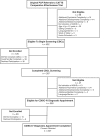Primary Care Management of Children with Attention-Deficit/Hyperactivity Disorder Appears More Assertive Following Brief Psychiatric Intervention Compared with Single Session Consultation
- PMID: 32167784
- PMCID: PMC7310318
- DOI: 10.1089/cap.2020.0013
Primary Care Management of Children with Attention-Deficit/Hyperactivity Disorder Appears More Assertive Following Brief Psychiatric Intervention Compared with Single Session Consultation
Abstract
Objectives: We examined primary care providers' (PCPs') management of attention-deficit/hyperactivity disorder (ADHD) during and following families' participation in two arms of the Children's ADHD Telemental Health Treatment Study. We hypothesized that more intensive treatment during the trial would show an "after-effect" with more assertive PCPs' management during short term follow-up. Methods: We conducted a pragmatic follow-up of PCPs' management of children with ADHD who had been randomized to two service delivery models. In the Direct Service Model, psychiatrists provided six sessions over 22 weeks of pharmacotherapy followed by behavior training. In the Consultation Model, psychiatrists provided a single-session consultation and made treatment recommendations to PCPs who implemented these recommendations at their discretion for 22 weeks. At the end of the trial, referring PCPs for both service delivery models resumed ADHD treatment for 10 weeks. We performed intent-to-treat analysis using all 223 original participants. We applied linear regression models on continuous outcomes, Poisson regression models on count outcomes, and logistic regression models to binary outcomes. Missing data were addressed through imputations. Results: Participants in the Direct Service Model had more ADHD visits than those in the Consultation Model across the full 32 weeks (mean = 7.05 visits vs. 3.36 visits; adjusted rate ratio = 2.1 [1.85-2.38]; p < 0.0001). During follow-up, participants in the DSM were more likely to be taking ADHD-related medications (82% vs. 61%; adjusted odds ratio = 2.44 [1.24-4.81], p = 0.01). At 32 weeks, participants in the Direct Service Model had higher stimulant dosages (adjusted difference = 5.64 [0.12-11.15] mg; p = 0.046). Conclusion: These results from a pragmatic follow-up of a randomized trial suggest an "after-effect" for brief intensive treatment in the Direct Service Model on the short term follow-up management of ADHD in primary care.
Trial registration: ClinicalTrials.gov NCT00830700.
Keywords: ADHD; pragmatic follow-up; primary care consultation; stimulant dose.
Conflict of interest statement
The authors have no financial relationships relevant to this article to disclose.
Figures


References
-
- American Academy of Child and Adolescent Psychiatry): Workforce Issues. 2019. Available at: https://www.aacap.org/AACAP/Resources_for_Primary_Care/Workforce_Issues.... Accessed March5, 2020
-
- American Academy of Pediatrics, Subcommittee on Attention-Deficit/Hyperactivity Disorder and Steering Committee on Quality Improvement and Management: ADHD: Clinical practice guideline for diagnosis, evaluation, and treatment of attention-deficit/hyperactivity disorder in children and adolescents. Pediatrics 128:1007–1022, 2011 - PMC - PubMed
-
- American Association of Medical Colleges: Recent Studies and Reports on Physician Shortages in the US. 2019. Available at: https://www.aamc.org/download/100598/data/ Accessed June1, 2019
Publication types
MeSH terms
Associated data
Grants and funding
LinkOut - more resources
Full Text Sources
Medical

